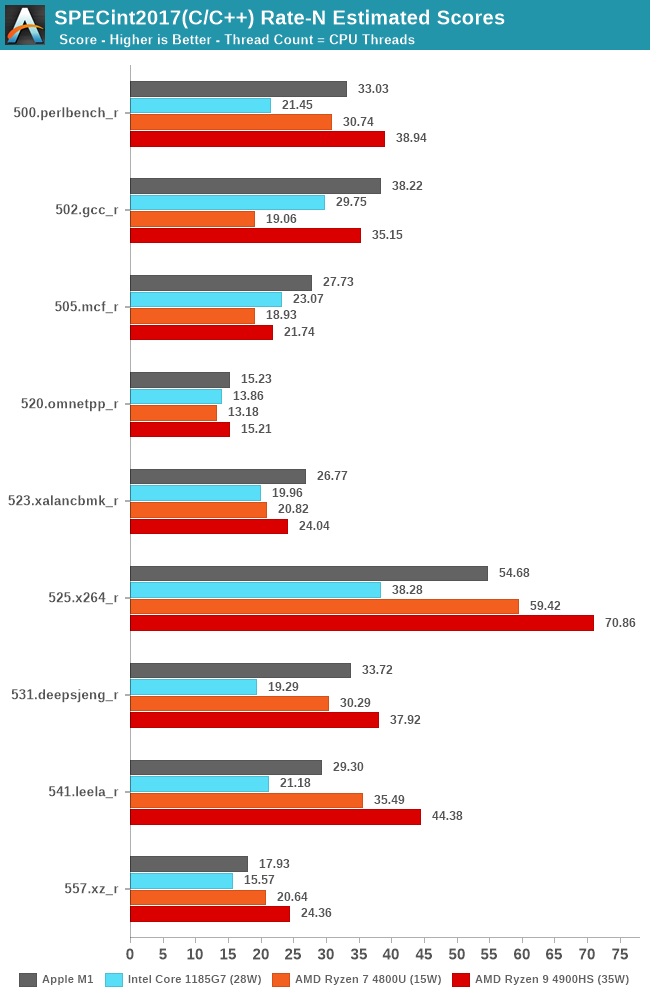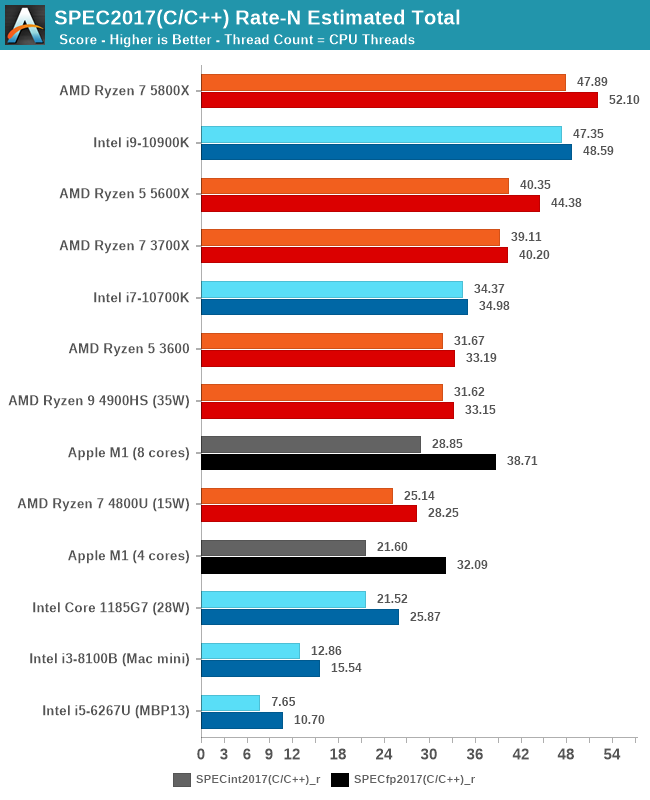The 2020 Mac Mini Unleashed: Putting Apple Silicon M1 To The Test
by Andrei Frumusanu on November 17, 2020 9:00 AM ESTSPEC2017 - Multi-Core Performance
While we knew that the Apple M1 would do extremely well in single-threaded performance, the design’s strengths are also in its power-efficiency which should directly translate to exceptionally good multi-threaded performance in power limited designs. We noted that although Apple doesn’t really publish any TDP figure, we estimate that the M1 here in the Mac mini behaves like a 20-24W TDP chip.
We’re including Intel’s newest Tiger Lake system with an i7-1185G7 at 28W, an AMD Ryzen 7 4800U at 15W, and a Ryzen 9 4900HS at 35W as comparison points. It’s to be noted that the actual power consumption of these devices should exceed that of their advertised TDPs, as it doesn’t account for DRAM or VRMs.

In SPECint2017 rate, the Apple M1 battles with AMD’s chipsets, with the results differing depending on the workload, sometimes winning, sometimes losing.

In the fp2017 rate results, we see similar results, with the Apple M1 battling it out with AMD’s higher-end laptop chip, able to beat the lower TDP part and clearly stay ahead of Intel’s design.

In the overall multi-core scores, the Apple M1 is extremely impressive. On integer workloads, it still seems that AMD’s more recent Renoir-based designs beat the M1 in performance, but only in the integer workloads and at a notably higher TDP and power consumption.
Apple’s lead against Intel’s Tiger Lake SoC at 28W here is indisputable, and shows the reason as to why Apple chose to abandon their long-term silicon partner of 15 years. The M1 not only beats the best Intel has to offer in this market-segment, but does so at less power.
I also included multi-threaded scores of the M1 when ignoring the 4 efficiency cores of the system. Here although it’s an “8-core” design, the heterogeneous nature of the CPUs means that performance is lop-sided towards the big cores. That doesn’t mean that the efficiency cores are absolutely weak: Using them still increases total throughput by 20-33%, depending on the workload, favouring compute-heavy tasks.
Overall, Apple doesn’t just deliver a viable silicon alternative to AMD and Intel, but actually something that’s well outperforms them both in absolute performance as well as power efficiency. Naturally, in higher power-level, higher-core count systems, the M1 can’t keep up to AMD and Intel designs, but that’s something Apple likely will want to address with subsequent designs in that category over the next 2 years.










682 Comments
View All Comments
Spunjji - Monday, November 23, 2020 - link
Not really - I don't own a Mac and don't ever plan to unless Boot Camp comes back. You're mistaken to assume I'm personally invested in this; I just don't like shitposters very much.taligentia - Tuesday, November 17, 2020 - link
Not sure what you're rambling about.Macbook Air, Mac Mini and the 13 MBP were always their low-end models.
Wait until their iMac Pro, Mac Pro are released. It will truly shake up the professional market.
KoolAidMan1 - Tuesday, November 17, 2020 - link
They're better at video editing, color correction, and image processing than other PCs.Show me a desktop PC that can scrub 8k video in DaVinci Resolve with no framedrops like the entry-level M1 in a 13" MBP can. Its exceedingly rare and incredibly expensive. I have a Threadripper workstation and am salivating at these
KoolAidMan1 - Tuesday, November 17, 2020 - link
If this is "entry level" then I can't wait to see what their high end machines with 32GB+ of RAM look like next yearhaghands - Tuesday, November 17, 2020 - link
Did you look at a single benchmark? Are benchmarks too complicated for your single brain cell?Silma - Tuesday, November 17, 2020 - link
It's good to have more competition.However, let's temper these praises: 2 of the most paramount reasons explaining this chip speed are not apple: microarchitecture is ARM, production is TSMC 5 nm.
The speed and power consumption of any Intel processor but made in 5 nm would be much similar to that of the M1.
Even from AMD we can expect automatically much better results in 5 nm than in 7 nm.
I would be very interested in seeing how competitive another ARM based TSCM 5 nm based SoC vs the M1. Perhaps from Qualcom or someone else.
Otritus - Tuesday, November 17, 2020 - link
Tsmc's 5nm node offers about a 30 decrease in power consumption over 7nm. That would imply a 28-34 watt tdp at 7nm which still keeps it ahead in efficiency. In terms of performance, no AMD and Intel would not perform better on 5nm. There is no reason to believe the TSMC 5nm process can clock higher(or even as high) than the 7nm process. Since performance is equal to ipc times clock speed, a new microarchitecture would be needed to perform better. Apple has over a 50 percent ipc lead over intel and over a 40 percent ipc lead over AMD.AlexDaum - Tuesday, November 17, 2020 - link
An AMD or Intel CPU on 5nm would not gain performance by higher clock speeds, but gain it using a wider CPU design, larger caches, more ALUs, probably a better branch predictor and larger reorder buffer. The M1 has a whopping 16 billion transistors, AMD renoir only 9.6 billion, so they could add a lot more logic on the same chip size, which would lead to better performance.The biggest challenge with scaling x86 CPUs to higher performance seems to be building wide decoders (AMD and Intel only have 4 wide decode, M1 has 8 wide, 1 x86 instruction can do more than 1 ARM64 instruction, but not twice as much).
andreltrn - Tuesday, November 17, 2020 - link
The problem with the X86 instruction set is that it has instruction of different size that don't match a wider architecture favorably. It is not that easy to achieve the high degree of parallelism of the M1 architecture with the X86 Instruction set. The 16 billions transistors are not only for the CPU and the GPU. There is a lot more in there! You can't compare the transistor count like that. This is a SOC.Otritus - Wednesday, November 18, 2020 - link
@AlexDaum1) As I said a new microarchitecture would be needed.
2) Ice/tiger lake already has 5 decoders (4 simple + 1 complex), and tremont has 6 decoders (run as 2 sets of 3, but intel says it can run as 1 set of 6).
3) Apples firestorm cores was designed for 2020 using the latest technology. Sunny cove was supposed to launch in 2017/18, with the next gen microarchitecture coming 2020/21. Intel also got lazy and didn't feel a need to speed up microarchitecture development and improve performance tremendously. So, intel is at 4/5 decoders with weak ipc compared to the competition.
4) AMD is still at 4 decoders because they have a limited engineering budget and need to focus on getting the best ROI. I would imagine zen 4 or zen 5 would look into going much wider because lots of the other performance enhancing routes have already been investigated, and AMD is in a better financial situation.